Diving into the heart of every garden, the Yellow Sweet Spanish Onion emerges as a beloved staple for its jumbo size, mild flavor, and golden-brown skin. The Yellow, Sweet Spanish onion, Granex onion, or Cebolla Chata is widely used in cooking due to their mild flavor and unique texture. This variety has a yellowish color and can be recognized by its flattened shape.
It thrives in warm regions like South Texas and Mexico. Celebrated by gardeners for its ease of growth and quick maturation, this onion variety not only brings culinary versatility to the table but also thrives in the camaraderie of a well-tended garden. With its robust nature and ability to store well, it encapsulates the joy of gardening, offering both a feast for the palate and a triumph for the green-thumbed enthusiast. Here are some further details regarding this unusual onion:
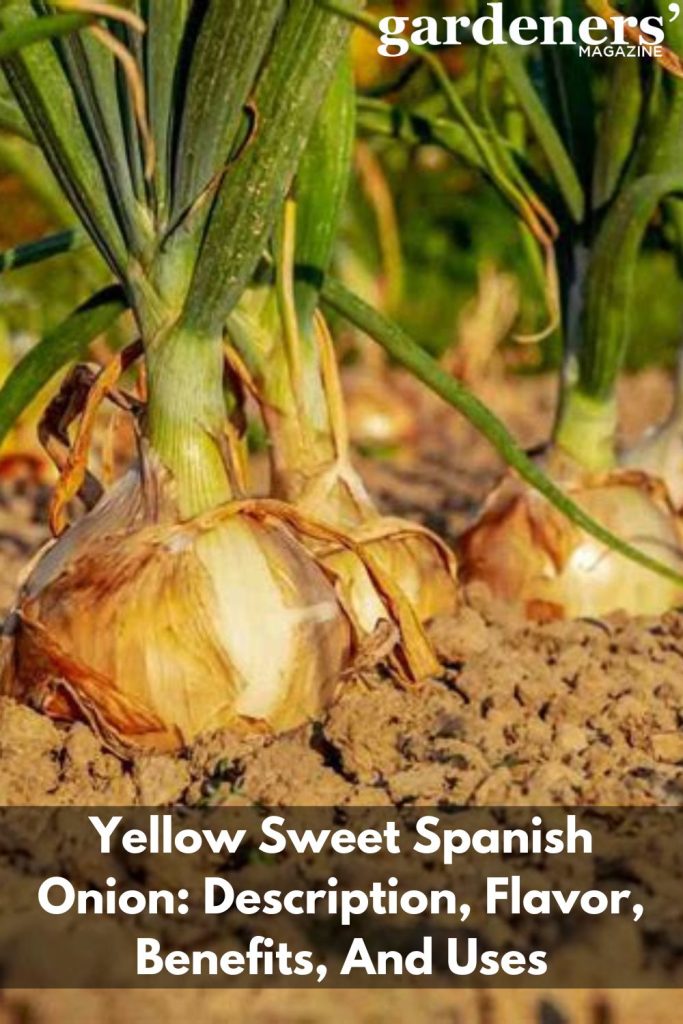
What is a Yellow Sweet Spanish Onion?
It is a type of sweet onion with a yellowish color and flattened shape. It is a variety known for its large size, mild flavor, and golden-brown skin. It is favored by gardeners for its ease of growth, quick maturation, and its excellent storage qualities. This onion adds a subtle sweetness to dishes without overwhelming other flavors, making it a versatile choice for culinary use. It is often called the Granex or Cebolla Chata, depending on where it is grown. The Yellow, Sweet Spanish onion is generally milder in flavor than other onions.
History and Origin of the Yellow Sweet Spanish Onion?
The Yellow Sweet Spanish Onion, a variant of Allium cepa, hails from the Mediterranean. Known for its yellow-brown hue and distinct sweetness, it’s a primary choice for culinary uses worldwide. This onion’s gentle taste makes it perfect for fresh dishes like salads and sandwiches, as well as for cooking and pickling. Its historical use dates back to ancient Egypt, around 3200 BC. Today, it remains a global kitchen staple, with significant annual consumption.
The history and origin of the Yellow Sweet Spanish Onion are intertwined with the broader history of onion cultivation, which dates back over 5,000 years. This particular variety is esteemed for its mild flavor and large size, attributes developed through selective breeding practices aimed at creating onions that were more palatable for raw consumption. The cultivation of sweet onions like the Yellow Sweet Spanish reflects a long history of agricultural innovation, where growers aimed to produce varieties that could offer both culinary versatility and ease of growth. While the specific origin details are complex, it’s clear that this onion variety is a product of generations of agricultural selection and adaptation, making it a favorite in gardens and cuisines worldwide.
Growing Conditions of Yellow Sweet Spanish Onion:
The Yellow Sweet Spanish Onion thrives in well-drained, fertile soil rich in organic matter with a pH between 6.0 and 7.5. It prefers a sunny location with at least 6 hours of direct sunlight daily and requiring temperatures between 13°C (55°F) and 24°C (75°F) for optimal growth. Planting should occur in early spring, with onions spaced about 4-6 inches apart to accommodate their large size. Regular watering is crucial, especially during the early stages of growth and bulb development, but it should be reduced as the onions mature.
A balanced fertilizer can support growth, but avoid those high in sulfur to prevent pungency. Use a balanced N-P-K fertilizer at planting and mid-season to support healthy growth. Avoid excessive nitrogen, which can delay bulb formation. Proper watering is crucial, particularly during bulb development, but reduce watering as the bulbs mature to avoid rot.
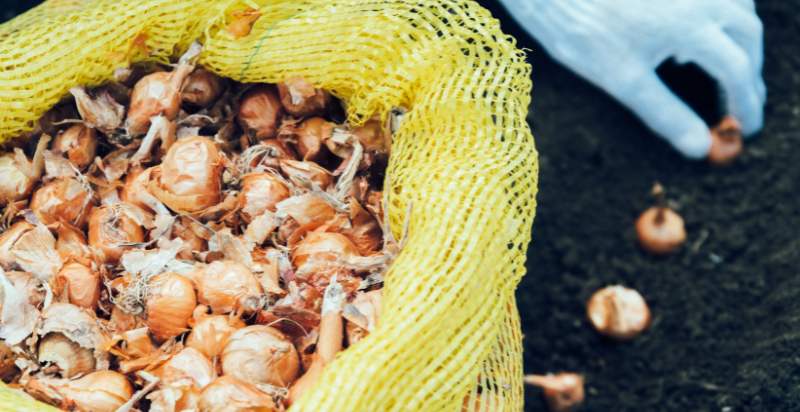
Health Benefits of Yellow Sweet Spanish Onion:
Yellow Sweet Spanish Onions offer a host of health benefits, making them a nutritious addition to any diet. These onions are a great source of vitamin C, a powerful antioxidant that supports the immune system and skin health. They also contain vitamin B6, which plays a crucial role in metabolism and brain health. Rich in fiber, they promote digestive health and may help in managing weight.
The presence of antioxidants like quercetin makes them beneficial for heart health by reducing blood pressure and inflammation. Additionally, their anti-inflammatory and antibacterial properties can aid in fighting infections and reducing the risk of chronic diseases such as cancer. Incorporating Yellow Sweet Spanish Onions into your diet not only adds flavor to dishes but also contributes to overall health and well-being.
Where are Yellow Sweet Spanish Onions Grown and Harvested?
Yellow Sweet Spanish onions are typically grown and harvested in climates with dry, warm summers and mild winters. Most of the production areas for this onion variety are found in Spain, although other countries such as Mexico, Argentina, Greece, and Chile all produce them. In the U.S., states like Idaho, Washington, and Oregon are known for their onion production. These onions are typically planted in early spring and harvested in late summer or early fall, depending on the local climate and growing conditions.
Their thick skins and sweet flavor make them well-suited to these regions, as they can tolerate more extreme temperatures. These onions are also grown in some parts of the United States, such as Texas and California. They are generally planted from late winter to early spring, with harvesting usually occurring from late summer through mid-autumn.
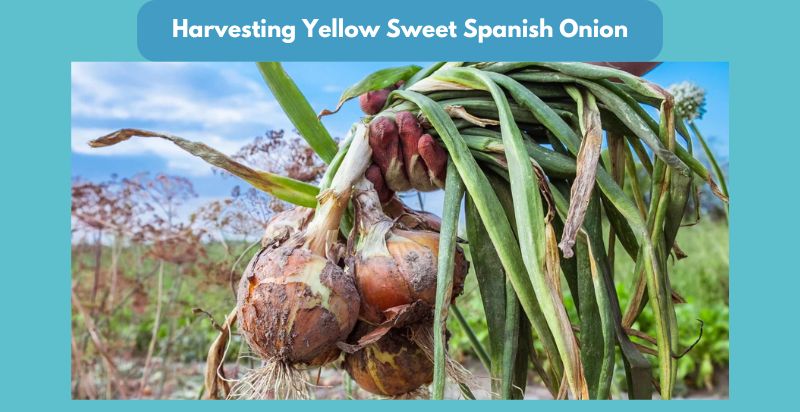
What is the Flavor Profile of the Yellow Sweet Spanish Onion?
The Yellow Sweet Spanish Onion is celebrated for its notably mild and sweet flavor, distinguishing it from more pungent onion varieties. This sweetness is complemented by a crisp texture that makes it a versatile ingredient suitable for a broad range of culinary uses. It has subtle hints of garlic and herb notes as it sautés. Ideal for raw applications like salads and sandwiches, its flavor also mellows beautifully when cooked, adding depth without overwhelming dishes. This unique flavor profile enables it to be a staple in kitchens, appealing to those who might find other onions too strong.
Where can the Best Quality Yellow Sweet Spanish Onion be found?
The best quality Yellow Sweet Spanish Onion can be found at specialty produce markets, grocery stores, and online retailers. Look for onions that are firm to the touch with vibrant yellow skin. When purchasing sweet Spanish onion bulbs, they should feel heavy in your hand and have a slightly sweet smell. Choose onions with no wilting or soft spots, and avoid any with blemishes. Buying sweet Spanish onions within a few days is best for optimum flavor and freshness.
How do you Store Yellow Sweet Spanish Onion?
The best way to store Yellow, Sweet Spanish Onion is in a cool, dry, and dark place. Do not store them near potatoes, as this will cause the onions to spoil quickly. For optimal storage of Yellow Sweet Spanish Onions, the key is ensuring a cool, dry environment with ample ventilation. Storing them in a mesh bag or basket in a pantry or cellar optimizes airflow, extending their freshness. Avoid exposure to sunlight and moisture, which can promote sprouting and spoilage. For longer storage, consider a dark, well-ventilated area with temperatures between 35°F and 50°F. Regularly inspect stored onions, removing any that show signs of decay to prevent them from affecting others. Properly stored, they can last for a considerable period, maintaining their flavor and nutritional value.
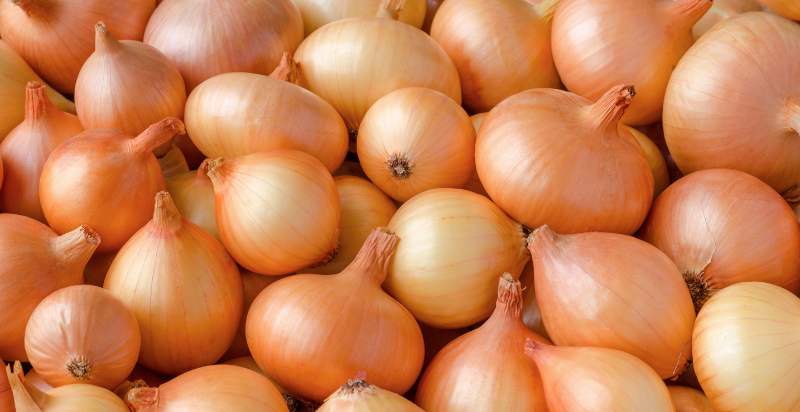
How to Use Yellow Sweet Spanish Onion in recipes?
Yellow Sweet Spanish onions are versatile and can be used in various recipes. Here are some ideas for how you can incorporate this delectable onion into your cooking:
- Saute it with bell peppers and garlic for a colorful side dish that adds flavor and texture to any meal.
- Cook sliced onions with sugar, vinegar, and spices until they are thick and jammy. This chutney can be used as a condiment for sandwiches, burgers, cheese plates, or as a topping for grilled meats.
- Add it to stir-fries for a unique flavor and crunchy texture.
- Layer it with thinly sliced apples or pears in an apple crisp or tart for a delightful dessert.
- Include it in pasta dishes to give your dishes a sophisticated boost of flavor.
- Add it to tacos, burritos, and other Mexican-inspired meals for some extra zest.
- Caramelized Onions can be prepared by slicing the onions thinly and cook them slowly in a bit of oil or butter over low heat until they are soft, sweet, and caramelized. These can be used as a topping for burgers, sandwiches, pizzas, or mixed into pasta dishes and risottos.
- Slice the onions into rings, dip them in a batter made from flour, eggs, and seasonings, and then fry them until crispy. Serve onion rings as a tasty appetizer or as a side dish.
- Roast it in the oven alongside carrots, sweet potatoes, and other root vegetables for a nutritious and filling vegetable medley.
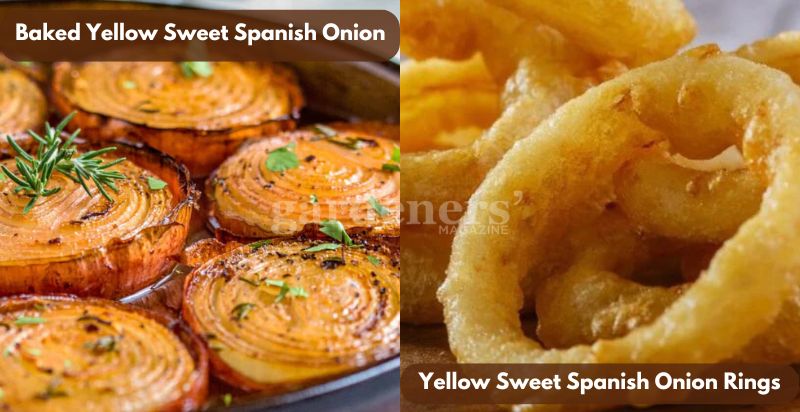
Conclusion:
No matter how you prepare them, sweet yellow Spanish onions are a delicious and healthy addition to any meal. Their mild sweetness can be added to almost anything for an extra burst of flavor! Plus, the antioxidants in these onions may help reduce inflammation and provide other health benefits. So don’t hesitate – give them a try today!
FAQs:
What are yellow sweet Spanish onions?
Yellow sweet Spanish onions are a type of onion known for their mild, sweet flavor and yellowish skin. They are popular for their versatility in cooking and can be used in various dishes.
How do I select ripe yellow sweet Spanish onions at the store?
Look for onions that are firm, with dry, papery skins and no soft spots or sprouting. The onion should feel heavy for its size. Avoid onions with any signs of mold or excessive bruising.
Can yellow sweet Spanish onions be substituted for other types of onions in recipes?
Yes, yellow sweet Spanish onions can generally be substituted for other varieties of onions in recipes. However, keep in mind that their mild and sweet flavor may differ slightly from other types of onions, so adjust seasoning accordingly.
Can I freeze yellow sweet Spanish onions?
Yes, you can freeze yellow sweet Spanish onions. To freeze them, peel and chop the onions, then spread them in a single layer on a baking sheet and freeze until solid. Once frozen, transfer the onions to a freezer bag or container and store them in the freezer for up to several months.
- Everything You Wanted to Know About Red Tamarillos - June 2, 2025
- A Guide to Tulips: Everything You Need to Know & More… - June 2, 2025
- Guanabana: Description, Flavor, Benefits, And Uses - May 27, 2025

9 thoughts on “Yellow Sweet Spanish Onion: Description, Flavor, Benefits, And Uses”
Comments are closed.